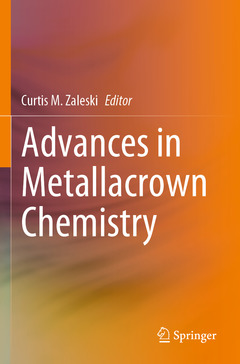1. Host-guest Chemistry of Metallacrowns
Bernadette L. Schneider and Vincent L. Pecoraro
1. Molecular recognition in Macrocycles
2. Building up systems of greater complexity
3. 15-MC-5 Host-Guest Chemistry
Conclusion
References
2. Aspects of NMR Characterization of Metallacrowns
Matteo Melegari and Matteo Tegoni
1. Introduction
2. 1H-NMR of Paramagnetic Complexes
3. Interaction of Metallacrowns with Inorganic and Organic Anions
4. Metal Exchange Equilibria
5. MC Rearragements and Ligand Exchange
Conclusions
References
3. Influence of the hydroxamate ligands’ structure on the thermodynamic properties and structure of metallacrown complexes
Malgorzata Ostrowska, Igor O. Fritsky, and Elzbieta Gumienna-Kontecka
1. Introduction
2. Hydroxamate derivatives as ligands for MCs
3. Self-assembly of metallacrown complexes
4. Thermodynamic properties of metallacrown complexes
5. Structural studies
6. Metallacrowns building blocks
Summary
References
4. Metallacrowns as DNA binders
Agata Głuszyńska and Bernard Juskowiak
1. DNA as a target for ligand binding
2. Analytical techniques for study Ligand/DNA interactions
3. Metallacrown complexes with DNA
Conclusions
References
5. Magnetic Metallacrowns: From Randomness to Rational Design
Thaddeus T. Boron, III
1. Introduction
2. Metallacrowns
3. Pseudo-Metallacrowns with Single-Molecule Magnetic Properties
4. Single-Molecule Magnetic Metallacrowns
Concluding Remarks
References
6. Beyond the metallacrown: Controlling first and second order coordination spheres towards discrete and extended architectures.
Leigh F. Jones
1. An introduction to discrete host-guest assemblies centred on metallacrown host units
2. Fluoro-centred host metallacrowns and their guest enticing abilities
3. Organometallic 12-MCM(III)-3 (M = Ru, Rh, Ir) metallacrown hosts
4. Controlling the first coordination sphere towards selective binding and topology control
5. Inverse metallacrowns and inverse crown ether complexes
Concluding Remarks
References
7. Water-soluble 15-Metallacrown-5 Complexes: Molecular Structures and Properties
Marina A. Katkova and Sergey Yu. Ketkov
1. Introduction
2. 15-MC-5 Structural Paradigm
3. Synthetic approaches to aqua complexes
4. Solution-state behavior
5. New similarities and analogues: Bi(III) vs. Ln(III)
Concluding Remarks
References
8. Metallacrown-based catalysts for water oxidation and CO2 reduction
Hua Yang, Jianmin Dou, and You Song
1. Water Oxidation
2. CO2 Conversion
Summary
References
9. A Structural Examination of Metallacrowns with Main Group Elements in the Ring Positions
Jacob C. Lutter and Curtis M. Zaleski
1. Introduction
2. Gallium-containing metallacrown complexes
3. Other main group metallacrown complexes
4. Azametallacrown complexes with main group elements
Conclusion
References
Index




